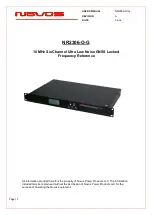
USERS MANUAL
NR2306-O/G
REVISION
A
DATE
3-8-18
Page | 7
2.1 GNSS Status
On power-up, the NR2306-O/G will display the Time and Date as well as the current status
of both GNSS receivers (if a dual-time base option was ordered).
GNSS: The GNSS status indication allows the user to observe the Lock status of the
receivers, and the number of GNSS satellites in view. Before GNSS lock is acquired, the
status will be “Tracking” and the number of satellites will be shown. When GNSS lock is
acquired, the status will change to “Lock.”
Time and Date: The time zone will be UTC by default, but the hour can be offset to the
local time in the UTC Offset menu. Changes to UTC offset and Hour mode will be reflected
on this screen, but will not change the NMEA output data.
2.2 GNSS Detailed Status
The GNSS Status Menu gives the user a quick reference for the quality of the GNSS
satellite signal and length of time that each receiver has been locked.
To toggle between each receiver, press the SELECT button. The screen will display which
receiver status is being viewed.
The user can then see the number of GPS satellites in view, number of GLONASS
satellites in view, and the UTC time and date that lock occurred on the selected receiver.
2.3 Channel Status
The Channel Status can be determined by reading the actual RMS value on the output of
each stage. This is compared to a threshold limit that is set by the user as a percentage
variation from a saved value. The default variation value is set at ±55% from the current
state of the amplifier and is user-programmable in 5% increments from ±10% to ±60%.






















